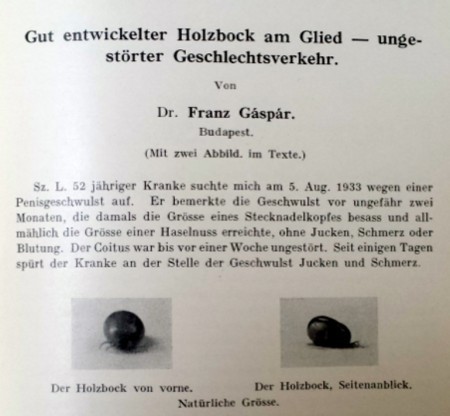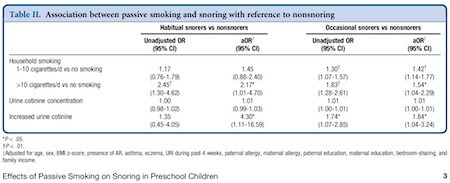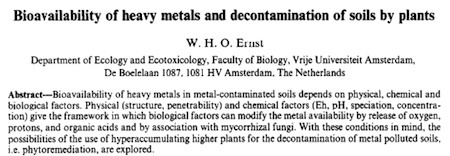Marc Abrahams's Blog, page 473
August 7, 2013
Ticks on dicks (1)
Ticks are a nuisance when they invade the human body. They prefer the damp and dark areas, like arm pits and groins. Dr. Franz Gáspár, from Budapest, Hungary, added an interesting case to the medical record.
A 52-year old male complained about a swelling on his penis that grew from the size of a pinhead to the size of a hazelnut. Upon inspection, a heavily swollen tick (Ixodes ricinus) was discovered halfway the length of his penis, and was removed without complication. The patient admitted he enjoyed sunbathing in swimming suit. All this was not noteworthy, dr Gáspár admitted, but as the patient confessed he had regular (5-6 days interval) untroubled intercourse during two months with the swollen tick firmly attached to his member, he decided to publish:
“Gut entwickelter Holzbock am Glied – ungestörter Geslechtsverkehr [Well-developed tick on member – undisturbed intercourse]” in Acta Dermato-Venereologica 15 (1934): 523-524

Compiled in close collaboration with dr Erwin J.O. Kompanje.
BONUS: video ‘A Tick burrowed under head of penis (short clip)‘

Nosocomical [sic] infections from Holy Water?
From a medical point of view, not all religious practices are always 100% risk free. See, for example, a recent Improbable article : ‘Official word: The body of Christ is not and cannot be gluten-free.’ But gluten intolerance is not the only area for concern – what about Holy Water in hospital chapels for example – is it safe? A 2012 paper published in the German journal Hygiene & Medizin : Infection Control and Healthcare describes a clinical investigation, the results of which suggest ‘perhaps not always’. ‘Holy water of hospital chapels as a possible source for nosocomical [sic] infections’ by Hubert Weiß.
“
The ongoing discussion about effective preventive measures against nosocomical [sic] infections concentrates very much on activities of hygiene management and on the search for all possible ways of introduction of germs into the clinical area. This analysis investigates whether holy water in hospital chapels may provide a possible reservoir for a contamination of patients in the clinical area as well as hospital equipment. The microbial count and the spectrum of bacteria detected in holy water lead to the conclusion that holy water should be integrated into the monitoring and the hygiene management of hospitals as a critical control point. This paper develops suggestions for the expansion of hygiene management and for the reduction of microbial counts in holy water fonts. Finally, liability issues will be discussed.”
NOTE: It’s very likely that the word ‘nosocomical’ used above should in fact be ‘nosocomial‘ - meaning an infection acquired in hospital (from the Greek word nosokomos ‘a person who tends the sick’.)

August 5, 2013
For Sex Researchers: How to Get the Attention You Want
 A bunch of people who do research on how people have sex came together to advise themselves and other people about how to get the kind of attention they want from people in the media.
A bunch of people who do research on how people have sex came together to advise themselves and other people about how to get the kind of attention they want from people in the media.
It’s all about the people. Here’s their report:
“Turning Sexual Science Into News: Sex Research and the Media,” Kimberly R. McBride, Stephanie A. Sanders [pictured here], Erick Janssen, Maria Elizabeth Grabe, Jennifer Bass, Johnny V. Sparks, Trevor R. Brown, Julia R. Heiman, Journal of Sex Research, Volume 44, Issue 4, 2007.

“Humans will befriend a stick — as long as it moves properly”
Maggie Koerth-Baker profiles, in BoingBoing, the story behind this moving video of how people respond to a stick that moves in ways that seem un-stick-likely. BoingBoing sums it up with the headline “Humans will befriend a stick — as long as it moves properly“:
A 2011 paper, by scientists at the University of Calgary, documenting the experiment, is online.

Garbling obliviousness and authenticity (cryptographically)
Lack of security in electronic communications can either be seen as a problem, or an asset, depending on your viewpoint. Either way, it’s a given that a great deal of high-end cryptographic research is currently underway. Accounts of recent progress can be found via Professor Mihir Bellare’s web page at the Department of Computer Science and Engineering at the University of California, San Diego, US.
For example, the professor has developed, along with colleagues Viet Tung Hoang and Phillip Rogaway, a highly optimised garbling scheme. See: ‘Foundations of garbled circuits.’ (in: Proceedings of the 19th ACM Conference on Computer and Communications Security (CCS), ACM, 2012. )
“Starting from a PRF [pseudorandom function] , we provide an efficient garbling scheme achieving privacy and we analyze its concrete security. We next consider obliviousness and authenticity, properties needed for private and verifiable outsourcing of computation.”
Full paper here : (45 pages, pdf)
Note: The professor also provides ‘An Automatic Crypto Research Topic or Paper Title Generator.’
BONUS paper : Leakage* by Daniel J. Bernstein, University of Illinois, Chicago : Ian Goldberg, University of Waterloo : Nadia Heninger, UCSD : Kevin S. McCurley, Google : and Moti Yung, Google. (Journal of Craptology : current issue, volume 8)
Improbable has not been able to determine whether this paper may, or may not, support tests for ‘Plausible Deniability‘.
Also see: The Index of Garbledness

August 4, 2013
Who is DR. WHO? Him.
Behold one of the many works of the (or a) real Dr. WHO:
W.H.O. Ernst, 1996. “Bioavailability of heavy metals and decontamination of soils by plants,” Applied Geochemistry, vol. 11, nos. 1–2, January–March 1996, pp. 163–167. Dr. Who is or was at the Department of Ecology and Ecotoxicology, Faculty of Biology, Vrije Universiteit Amsterdam, The Netherlands.
BONUS: W.H.O. Shortt, 1921. “A few hints on crocodile shooting,” Journal of the Bombay Natural History Society, 29:77.

Effect of Skull Shape and Size on Musical Preference
Your skull, as much as what’s in it, may affect your musical taste, suggests this study:
“Music of the Body: An investigation of skull resonance and its influence on musical preference,” Jitwipar Suwangbutra, Rachelle Tobias and Michael S. Gordon [a portion of whose skull is pictured here, encased in fleshy material], paper presented at the 165th Acoustical Society of America Meeting, June 4, 2013, in Montreal, Canada. The authors, at William Paterson University, Wayne, New Jersey, explain:
“since the size, density, and even shape of a person’s skull is somewhat unique, that resonance will vary across individuals. Our current research was designed to explore whether this uniqueness in skull resonance might have a direct influence on the kinds of music a person prefers…. The influence of skull resonance on music preference was studied across a series of experiments. Listeners were presented with a set of original melodies and were asked to judge how much they enjoyed each selection…. this research suggests that the skull [shape and size] might influence the music that a person dislikes rather than the music a person likes.”
Further detail from the study:
[image error]
“Results from Experiment 2, the ratio of Musical Key to Resonant Skull Frequency (Hz). Results are segregated by Lowest, Middle, and Highest preference”
(Thanks to investigator Scott Langill for bringing this to our attention.)

August 3, 2013
Effects of Passive Smoking on Snoring in Preschool Children
This new study is one of the few to try to make an attempt to assess the existence or nonexistence of effects of passive smoking on snoring in preschool children:
“Effects of Passive Smoking on Snoring in Preschool Children,” Yin Zhu, Chun Ting Au, Ting Fan Leung, Yun Kwok Wing, Christopher Wai Kei Lam, Albert Martin Li, Journal of Pediatrics, epub July 1, 2013. The authors, at the Chinese University of Hong Kong and Macau University of Science and Technology, explain:
“Objective: To examine the association between passive smoking and snoring in preschool children using parent-reported questionnaires and urine cotinine levels… Cotinine, a major degradation product of nicotine metabolism, has become an important biomarker for quantifying passive exposure to cigarette smoke….
“Conclusion: Environmental tobacco smoke exposure is an independent risk factor for snoring in preschool children.”
Here’s detail from the study:

One of the few earlier studies is:
“Snoring and Passive Smoking: A Counterblaste?” Ron Grunstein, American Journal of Respiratory and Critical Care Medicine, vol. 170, no. 7, 2004, pp. 722-723. The author, at Woolcock Institute of Medical Research in Sydney, Australia, discusses those earlier studies, and also King James I of England.

August 2, 2013
Smirkness in Economics
Those who follow developments in the derivatives market, and particularly in its sub-section, the options market, may be aware of the concept of Smirkness. It was first proposed at the 2005 China International Conference in Finance, where professors Jin Zhang and Yi Xiang presented their paper ‘Implied Volatility Smirk’
“In this paper, we propose a new concept of smirkness, which is defined as a triplet of at-the-money implied volatility, skewness (slope at the money) and smileness (curvature at the money) of implied volatility-moneyness curve.”
The paper not only covered ‘The Dynamics of Smirkness’ [page 18] but also laid out ‘The Applications of Smirkness’ [page 19]. For clarification, another publication from professor Jin Zhang – also titled ‘Implied Volatility Smirk’ gives an etymological history of the term :
“After the market crash in 1987, the implied volatility as a function of strike price is skewed towards the left. The phenomenon is regarded as implied volatility smirk. Smirk = skew + smile”
And a third paper from the team, this one called : ‘The Implied Volatility Smirk’ went into even greater detail – and this time provided graphs like the one above which showed : “The flat, skewed and smirked implied volatility functions together with market implied volatilities (shown as dots) on 4 November 2003 for SPX options that mature on 21 November 2003.”
BONUS : Another viewpoint on derivatives : from Philip Coggan writing in his book ‘Paper Promises : Money, Debt and the New World Order’, (Allen Lane, 2011, Hardback, p. 170)
“Banks may have had an ulterior motive for the growth of derivatives. The more complex the product, the harder it was for investors to see the price. The result was fat fees for the banking sector.”

August 1, 2013
A circumcision device “similar to a pizza cutter”
New technology to watch out for:
“CIRCUMCISION DEVICE AND PROCEDURE,” US patent application 2012/0303040, R. Michael Johnson, York, PA, (US); Pietro Ranieri, Haddonfeld, NJ (US); Kristin Chrouser, Baltimore, MD (US); Sheila Green, November 29, 2012. The document includes this statement:
“Several alternative cutting means can be used to make the circumcision cut around the circumference of the foreskin. Among these are a scalpel, a rotary cutting instrument (similar to a pizza cutter), a cutter of the configuration as used to cut the foil on a wine bottle, or a garrote (thin wire).”
This drawing, from the patent, shows an idealized version of the device:
BONUS: A video interview, about modern medical care in general, with co-inventor Kristin Chrouser, MD, MPH:
BONUS (mostly unrelated): Pizza circumcision:

Marc Abrahams's Blog
- Marc Abrahams's profile
- 14 followers







